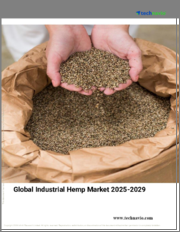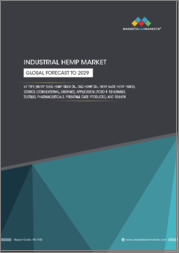
|
시장보고서
상품코드
1616729
세계의 산업용 헴프 시장 : 성장 기회, 성장 촉진요인, 산업 동향 분석과 예측(2024-2032년)Industrial Hemp Market Opportunity, Growth Drivers, Industry Trend Analysis, and Forecast 2024 - 2032 |
||||||
세계 산업용 헴프 시장은 2023년에 2억 4,200만 달러에 이르고, 2024-2032년에 걸쳐 CAGR 6.2%로 성장할 것으로 예측됩니다.
이러한 증가 경향은 섬유, 음식, 건설 등 다양한 산업에서 헴프의 채용이 증가하고 있는 것이 배경에 있습니다. 매우 인기있는 상품으로 자리 잡고 있습니다. 또한 세계 각국 정부는 헴프 재배에 관한 규제를 완화하고 있으며, 이 다목적 식물에서 얻은 제품 수요를 더욱 밀어 올리고 있는 것이 배경에 있습니다.
헴프는 물의 소비량이나 농약의 필요성이 적은 등 환경면에서 뛰어나고, 기존 자원을 대신하는 매력적인 선택지가 되고 있습니다. 따라서 환경 의식이 높은 시장에서 그 매력이 높습니다. 지속가능성을 둘러싼 소비자의 의식의 높아짐과 식물 유래 제품의 인기가 높아져, 시장의 확대를 한층 더 밀어주고 있습니다.
섬유 부문은 2023년에 1,880만 달러로 평가되었고, 2032년까지 연평균 복합 성장률(CAGR) 5.9%로 성장할 것으로 예상되고 있습니다. 의류에서 가정용 섬유에 이르기까지 다양한 제품을 만들 수 있습니다. 2032년까지 약 1억 330만 달러에 이르는 것으로 예상되며, 예측기간 중 CAGR은 6.7% 이상의 기세입니다.
| 시장 범위 | |
|---|---|
| 시작년 | 2023년 |
| 예측년 | 2024-2032년 |
| 시작 가격 | 2억 4,200만 달러 |
| 예상 가격 | 4억 2,220만 달러 |
| CAGR | 6.2% |
헴프 시드는 필수 지방산, 단백질, 비타민, 미네랄을 풍부하게 포함하는 것으로 알려져 있으며, 단백질 분말, 스낵, 음료 등 건강 지향의 아이템에 자주 사용됩니다. 7.5%를 나타내, 2032년까지 8,750만 달러에 달할 전망입니다. 미국의 최근 법 개정에 의해 헴프 재배가 합법화된 것이, 이 지역 시장 성장에 크게 박차를 가하고 있습니다. 농업 종사자가 마 재배를 모색하도록 촉구하고 북미 시장에서 헴프 기반 제품의 광범위한 가용성으로 이어지고 있습니다.
목차
제1장 조사 방법과 조사 범위
제2장 주요 요약
제3장 산업 인사이트
- 생태계 분석
- 공급자의 상황
- EPB 제조업체
- 컴포넌트 제조업체
- OEM 제조업체
- 유통업체
- 최종 사용자
- 이익률 분석
- 전동 주차 브레이크의 가격 분석
- 기술과 혁신의 전망
- 주요 뉴스와 대처
- 규제 상황
- 영향요인
- 성장 촉진요인
- 고급 안전 기능에 대한 수요 증가
- 차량 효율의 향상과 경량화의 추진
- 브레이크 시스템의 기술 진보
- 전기자동차와 하이브리드 자동차의 채용 확대
- 산업의 잠재적 리스크 및 과제
- EPB 시스템과 유지 보수의 높은 비용
- 전자부품의 신뢰성 문제의 가능성
- 성장 촉진요인
- 성장 가능성 분석
- Porter's Five Forces 분석
- PESTEL 분석
제4장 경쟁 구도
- 소개
- 기업 점유율 분석
- 경쟁 포지셔닝 매트릭스
- 전략 전망 매트릭스
제5장 시장 추정·예측 : 유형별, 2021-2032년
- 주요 동향
- 케이블 풀 시스템
- 캘리퍼 일체형 시스템
제6장 시장 추정·예측 : 컴포넌트별, 2021-2032년
- 주요 동향
- 전자제어유닛(ECU)
- 액추에이터
- 스위치
- 기타
제7장 시장 추정·예측 : 자동차별, 2021-2032년
- 주요 동향
- 승용차
- 상용차
- 소형 상용차
- 중형 상용차
- 대형 상용차
제8장 시장 추정·예측 : 유통 채널별, 2021-2032년
- 주요 동향
- OEM
- 애프터마켓
제9장 시장 추정·예측 : 지역별, 2021-2032년
- 주요 동향
- 북미
- 미국
- 캐나다
- 멕시코
- 유럽
- 영국
- 독일
- 프랑스
- 스페인
- 이탈리아
- 러시아
- 북유럽
- 아시아태평양
- 중국
- 인도
- 일본
- 한국
- 뉴질랜드
- 동남아시아
- 라틴아메리카
- 브라질
- 멕시코
- 아르헨티나
- 중동 및 아프리카
- 아랍에미리트(UAE)
- 남아프리카
- 사우디아라비아
제10장 기업 프로파일
- HempFlax BV
- North American Hemp & Grain Co. Ltd.
- Terra Tech Corp.
- Fresh Hemp Foods, Ltd.
- Hempco Food and Fiber Inc.
- American Hemp LLC
- Panda BIoTech, LLC.
- East Yorkshire Hemp
- Bombay Hemp Company
- Industrial Hemp(U) Ltd.
- Gohemp
- Marijuana Company of America Inc.
- Global Hemp Group Inc.
- Valley Bio Limited
The Global Industrial Hemp Market reached USD 242 million in 2023 and is anticipated to grow at a CAGR of 6.2% from 2024 to 2032. This upward trend is fueled by the rising adoption of hemp across various industries, notably textiles, food and beverages, and construction. The multifaceted nature of industrial hemp, cultivated for its fibers, seeds, and oil, positions it as a highly sought-after commodity. Moreover, global governments are relaxing regulations on hemp cultivation, further boosting demand for products derived from this versatile plant. Significant growth in the industrial hemp sector is driven by an increasing preference for sustainable materials within textiles, construction, and the food and beverage industries.
Hemp's environmental advantages, including reduced water consumption and lower pesticide needs, make it an attractive alternative to traditional resources. Its cultivation requires substantially less water than cotton, enhancing its appeal in environmentally conscious markets. The surge in consumer awareness surrounding sustainability and the rising popularity of plant-based products further propel market expansion. The plant-based food sector has witnessed considerable growth, highlighting this trend.
The textiles segment, valued at USD 18.8 million in 2023, is expected to grow at a CAGR of 5.9% through 2032. Hemp fibers are increasingly recognized for their sustainability and adaptability, making them a preferred choice in the textile industry. Renowned for their strength and durability, these fibers resist abrasion and can create a diverse array of products, from clothing to home textiles. The food and beverages segment is projected to reach approximately USD 103.3 million by 2032, with a robust CAGR of over 6.7% during the forecast period. This growth is driven by the rising incorporation of hemp seeds and oil as nutritious ingredients in various food products.
| Market Scope | |
|---|---|
| Start Year | 2023 |
| Forecast Year | 2024-2032 |
| Start Value | $242 Million |
| Forecast Value | $422.2 Million |
| CAGR | 6.2% |
Hemp seeds are celebrated for their wealth of essential fatty acids, proteins, vitamins, and minerals, making them a popular addition to health-focused items such as protein powders, snacks, and beverages. North America industrial hemp market is poised to exhibit a CAGR of 7.5%, reaching USD 87.5 million by 2032. The legalization of hemp cultivation under recent legislative reforms in the United States has significantly spurred market growth in the region. This shift has encouraged farmers to explore hemp cultivation, leading to a broader availability of hemp-based products within the North American market.
Table of Contents
Chapter 1 Methodology & Scope
- 1.1 Research design
- 1.1.1 Research approach
- 1.1.2 Data collection methods
- 1.2 Base estimates and calculations
- 1.2.1 Base year calculation
- 1.2.2 Key trends for market estimates
- 1.3 Forecast model
- 1.4 Primary research & validation
- 1.4.1 Primary sources
- 1.4.2 Data mining sources
- 1.5 Market definitions
Chapter 2 Executive Summary
- 2.1 Industry 360° synopsis, 2021 - 2032
Chapter 3 Industry Insights
- 3.1 Industry ecosystem analysis
- 3.2 Supplier landscape
- 3.2.1 EPB manufacturers
- 3.2.2 Component manufacturers
- 3.2.3 OEMs
- 3.2.4 Distributors
- 3.2.5 End-users
- 3.3 Profit margin analysis
- 3.4 Price analysis of electric parking brakes
- 3.5 Technology & innovation landscape
- 3.6 Key news & initiatives
- 3.7 Regulatory landscape
- 3.8 Impact forces
- 3.8.1 Growth drivers
- 3.8.1.1 Increasing demand for advanced safety features
- 3.8.1.2 Push towards enhanced vehicle efficiency and reduced weight
- 3.8.1.3 Technological advancements in braking systems
- 3.8.1.4 Growing adoption of electric and hybrid vehicles
- 3.8.2 Industry pitfalls & challenges
- 3.8.2.1 High cost of EPB systems and maintenance
- 3.8.2.2 Potential reliability issues with electronic components
- 3.8.1 Growth drivers
- 3.9 Growth potential analysis
- 3.10 Porter's analysis
- 3.11 PESTEL analysis
Chapter 4 Competitive Landscape, 2023
- 4.1 Introduction
- 4.2 Company market share analysis
- 4.3 Competitive positioning matrix
- 4.4 Strategic outlook matrix
Chapter 5 Market Estimates & Forecast, By Type, 2021 - 2032 ($Bn, Units)
- 5.1 Key trends
- 5.2 Cable-pull systems
- 5.3 Caliper integrated systems
Chapter 6 Market Estimates & Forecast, By Component, 2021 - 2032 ($Bn, Units)
- 6.1 Key trends
- 6.2 Electronic control unit (ECU)
- 6.3 Actuator
- 6.4 Switch
- 6.5 Others
Chapter 7 Market Estimates & Forecast, By Vehicle, 2021 - 2032 ($Bn, Units)
- 7.1 Key trends
- 7.2 Passenger vehicles
- 7.3 Commercial vehicles
- 7.3.1 Light commercial vehicles
- 7.3.2 Medium commercial vehicles
- 7.3.3 Heavy commercial vehicles
Chapter 8 Market Estimates & Forecast, By Sales Channel, 2021 - 2032 ($Bn, Units)
- 8.1 Key trends
- 8.2 OEM
- 8.3 Aftermarket
Chapter 9 Market Estimates & Forecast, By Region, 2021 - 2032 ($Bn, Units)
- 9.1 Key trends
- 9.2 North America
- 9.2.1 U.S.
- 9.2.2 Canada
- 9.2.3 Mexico
- 9.3 Europe
- 9.3.1 UK
- 9.3.2 Germany
- 9.3.3 France
- 9.3.4 Spain
- 9.3.5 Italy
- 9.3.6 Russia
- 9.3.7 Nordics
- 9.4 Asia Pacific
- 9.4.1 China
- 9.4.2 India
- 9.4.3 Japan
- 9.4.4 South Korea
- 9.4.5 ANZ
- 9.4.6 Southeast Asia
- 9.5 Latin America
- 9.5.1 Brazil
- 9.5.2 Mexico
- 9.5.3 Argentina
- 9.6 MEA
- 9.6.1 UAE
- 9.6.2 South Africa
- 9.6.3 Saudi Arabia
Chapter 10 Company Profiles
- 10.1. HempFlax B.V.
- 10.2. North American Hemp & Grain Co. Ltd.
- 10.3. Terra Tech Corp.
- 10.4. Fresh Hemp Foods, Ltd.
- 10.5. Hempco Food and Fiber Inc.
- 10.6. American Hemp LLC
- 10.7. Panda Biotech, LLC.
- 10.8. East Yorkshire Hemp
- 10.9. Bombay Hemp Company
- 10.10. Industrial Hemp (U) Ltd.
- 10.11. Gohemp
- 10.12. Marijuana Company of America Inc.
- 10.13. Global Hemp Group Inc.
- 10.14. Valley Bio Limited



















